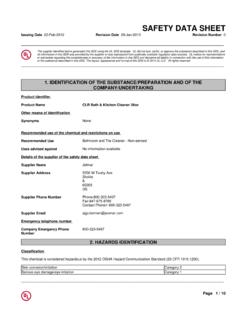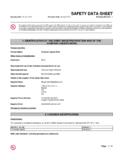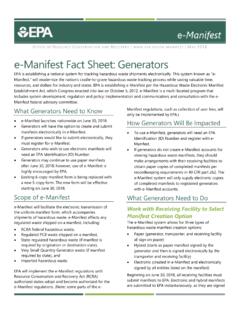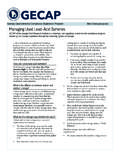Transcription of FACT SHEET - tacinc.org
1 fact SHEETAUGUST 2003 LIVE-IN AIDES AND THE HOUSING CHOICE VOUCHER PROGRAMW ritten by:Lisa SloaneSloane Associates160 Orchard , MA 01238 Emily Cooper and Ann O HaraThe Technical Assistance Collaborative, Boylston St, Ste. 1301 Boston, MA subcontract to: Abt Associates Square, Ste. 6004800 Montgomery LaneBethesda, MD under contract Department of Housing and Urban DevelopmentOffice of Public and Indian HousingReal Estate and Housing Performance DivisionWashington, #C-OPC-21702, Task Order DEN-T0004 LIVE-IN AIDES AND THE HOUSING CHOICE VOUCHER PROGRAMI ncreasingly, people with disabilities are applying for andbecoming participants in housing programs administeredby Public Housing Agencies (PHAs), including theHousing Choice Voucher Program (HCVP). This trend is aresult of many factors including: growing preferences amongpeople with disabilities for community-based housing;changes in state and federal civil rights laws; and increasedfunding for programs targeted to people with disabilities, suchas the HCVP Mainstream Housing Opportunities for Personswith Disabilities program as well as other federal programsthat assist people with disabilities, such as of the issues that PHAs often face when assistingpeople with disabilities through the HCVP is that of live-inaides.
2 This fact SHEET provides information on live-in aidesincluding Department of Housing and Urban Develop-ment (HUD) regulatory requirements and key definitionsas well as ideas for PHAs to consider in setting local stan-dards for review and approval of live-in is a Live-In Aide?Personal care attendant, aide, supportive helper, atten-dant services and many other phrases are used across thecountry to describe the new model of personal care assistancepreferred by many people with disabilities. These helpers assistpeople with disabilities to accomplish activities of daily living,including personal care, which the individual is not able toperform because of his/her disability. They can assist in mealpreparation, shopping, toileting, dressing, bathing, and manyother tasks. For example, a person in a wheelchair might needhands-on assistance in moving from the chair to the bed. Forsomeone with a cognitive disability, the assistance may be moresupervisory.
3 From the perspective of a person with a disability, the attendant is like their arms and legs, or memory. 1 fact SHEETP ersonal peoplewith disabilitiesto accomplishactivities of dailyliving, includingpersonal care, whichthe individual isnot able to performbecause of Fromthe perspective ofa person with adisability, theattendant is liketheir arms andlegs, or memory. THE TECHNICAL ASSISTANCE COLLABORATIVE, Thomas, A DisabilityPerspective on Home HealthCare available online AIDES AND THE HOUSING CHOICE VOUCHER PROGRAMSome people with disabilities may require assistance dur-ing the night as well as during the day. For example, somepeople with physical disabilities may need assistance beingre-positioned throughout the evening to prevent , a person with a disability will have a live-in aide who lives with the individual and provides servicesas needed. An individual who has a live-in aide may alsohave other aides who provide assistance during the recent years, more and more people with disabilitiesare living in housing in the community rather than in institu-tional settings.
4 This trend is due to many factors including: The Independent Living Movement that emphasizes therights of people with disabilities to control their ownlives and be active members of the community; Federal and state civil rights laws that dictate that peoplewith disabilities have access to a wide range of publicprograms, including housing programs; Efforts to deinstitutionalize people with disabilitiesby providing them with community-based housingalternatives; and New advances in medical and supportive services thatallow people with disabilities to get their health needsmet in a variety of recently, in 1999, as part of the Olmstead vs. , the Supreme Court affirmed that under theAmericans with Disabilities Act (ADA) states may no longerconfine people with disabilities unnecessarily in restric-tive settings such as institutions or segregated Olmstead is, in essence, essentially a case aboutde-institutionalization, a key question central to Olmstead-planning efforts is where will people with disabilities live?
5 As a result of this decision, more people with disabilities many of whom are low-income will be seeking commu-nity-based housing opportunities. They will need housingassistance such as a voucher as well as support from alive-in aide in order to maintain residential the more traditional model of home health aidesor homemakers, in which the aide is an employee of anAs a result of thisdecision, morepeople withdisabilities manyof whom are low-income will beseeking community-based housingopportunities. Theywill need housingassistance such asa voucher as wellas support froma live-in aide inorder to maintainresidential TECHNICAL ASSISTANCE COLLABORATIVE, AIDES AND THE HOUSING CHOICE VOUCHER PROGRAM agency such as a Visiting Nurses Association that providesoccasional visits, live-in aides are directed, hired, and oftenemployed by a person with a disability. However, theirsalary may be paid for in various ways and from differentsources.
6 For example, a live-in aide may be paid by an agencyor directly by the individual with the disability. The cost ofa live-in aide may be paid for by private or public sourcessuch as Medicaid, the Veteran s Administration, orvocational rehabilitation programs. PHAs do not have topay for live-in Regulatory Requirements andStandards for Live-In AidesHUD regulations include specific requirements andstandards related to live-in aides in the HCVP. However,according to HUD, PHAs are also permitted to establishadditional standards. Specifically, according to 24 CFR (h)(4), a PHA has the discretion to adopt reasonablepolicies concerning residence live-in aide, and definingwhen PHA consent may be given and denied. A PHA spolicies regarding live-in aides must be documented in itsSection 8 Administrative key issue from HUD s perspective is whether a helperis a live-in aide that is, whether the housing is the aide sprimary residence.
7 Helpers who come and go during theday are considered guests or employees of the their behavior violates the lease, the presence of anon live-in aide is not of interest to the PHA. However, ifthe aide lives with the HCVP participant, then a number ofHUD regulations, including those regarding incomeexclusions and household size, become relevant. Theseregulations are described Requirement to Allow Live-in Aide if Neededas a Reasonable AccommodationAreasonable accommodation is an action taken by aPHA to change the rules, policies, practices, or servicesso that a person with a disability can have equal opportunityto obtain housing and to use and enjoy his/her key issue fromHUD s perspective iswhether a helper is alive-in aide that is,whether the housingis the aide s primaryresidence. Helperswho come and goduring the day areconsidered guests oremployees of theparticipant. Unlesstheir behavior violatesthe lease, thepresence of a nonlive-in aide is not ofinterest to the TECHNICAL ASSISTANCE COLLABORATIVE, AIDES AND THE HOUSING CHOICE VOUCHER PROGRAMA pproving a live-in aide, if needed by a disabled household,is an example of a reasonable to HUD regulations (24 CFR ), PHAsare required to approve a live-in aide if needed as a reason-able accommodation for a disabled household.
8 A family that consists of one or more elderly, near-elderly or disabled persons may request that the PHAapprove a live-in aide to reside in the unit andprovide necessary support services for a familymember who is a person with disabilities. The PHAmust approve a live-in aide if needed as a reasonableaccommodation in accordance with 24 CFR part 8to make the program accessible to and usable by afamily member with a PHAs must inform all HCVP households oftheir right to request a reasonable accommodation, ulti-mately it is the disabled household that is responsible formaking the HCVP Definition of Live-in AideHCVP regulations (24 CFR ) define a live-inaide as:A person who resides with one or more elderlypersons or near-elderly persons or persons withdisabilities and who:1Is determined to be essential to the care and well-being of the persons;2Is not obligated for the support of the persons;and3 Would not be living in the unit except to providethe necessary supportive does the regulation set out such a specific definition?
9 Since housing funds are limited and there are many eligiblefamilies on PHA waiting lists, PHAs must ensure that a live-in aide is necessary for the support of a person with a described later, there are financial implications todetermining a live-in aide as a household member, includingthe exclusion of the aide s income from determination ofhousehold toHUD regulations,PHAs are requiredto approve a live-in aide if neededas a reasonableaccommodationfor a TECHNICAL ASSISTANCE COLLABORATIVE, AIDES AND THE HOUSING CHOICE VOUCHER PROGRAMT here are two key components to the HCVP live-in aidedefinition: What is essential care and how does a person with adisability prove that this type of care is needed; and How does a PHA determine that the housing is the live-in aide s primary residence and that the live-in aide wouldnot normally be living in the unit except to provide sup-portive CareThe HCVP regulations do not specifically define essential care.
10 The HUD HCVP Guidebook recommends written certification from doctor or rehabilitation agencythat care is necessary to employment of household member. 2 For household members who require an attendant not foremployment but simply to assist in activities of daily living,written certification from a doctor or other professionalwould be appropriate. This is an area where PHAs maychoose to expand upon HUD s standards. For example, aPHA might accept documentation of need for a live-in aidefrom a non-medical agency that provides services to peoplewith disabilities, such as a Center for Independent the Residence of the Live-in AideHUD regulations seek to distinguish between ahousehold member who would normally be expected to livein the unit and provide supports to a person with a disability such as a spouse or parent and an individual who hasjoined the household solely for purposes of caretaking. Hereagain, PHAs may want to consider establishing their ownstandards or policies.


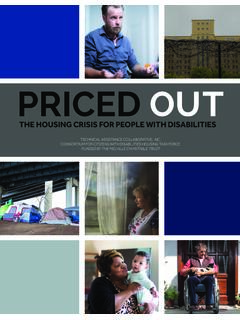

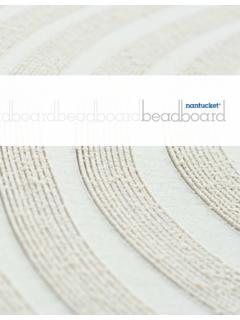

![Crown Hydro Term Sheet[1]](/cache/preview/8/e/d/7/2/7/4/9/thumb-8ed727496d7da8b9fd30399247e471a5.jpg)
